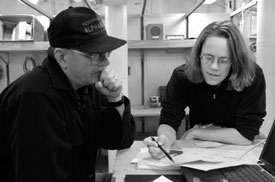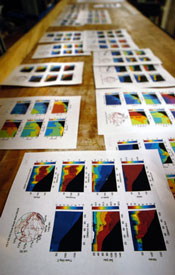 |
Daily Update
Calendar
Dispatch 34 - October 13, 2003
By C. A. Linder
Weather conditions: Overcast skies, 15 kt winds, 1-2 ft seas,
air temperature 32°F
Fruits of our Labor
Every night after finishing the dispatch I click on my headlamp
and take a leisurely stroll around the decks before heading to my
stateroom. Last night was quite a surprise - no headlamp required.
After so many days of overcast skies, seeing the moon shining brightly
in the sky was quite a shock. Only a few ribbons of clouds hung
on the horizon. The moon was so bright that my shadow was clearly
visible. The view from on top of the pilot house was incredible
- the bow was pointed straight into river of silvery light.
After such a clear night I woke up early expecting a bright sunrise. But the clouds had returned - a now-familiar blanket of gray. Snow squalls came and went today as our CTD sampling took us into deeper and deeper waters.
 |  |
| Dean Stockwell and Sarah Zimmermann discuss the latest CTD data. |
| Click
to enlarge |
As we collect more and more CTD data, the struggle to understand it all, to put together a story of what these waters are doing, has begun. Lively discussions have sprung up in the main lab around the chart table or the multitude of plots that we have created. This is only the very beginning of many months, even years, of careful consideration of what these numbers may mean for the future of the Arctic Ocean.
Mrs. Lyons' 5th grade class at Mt. Alvernia Academy, Chestnut
Hill, Massachusetts sent me these great questions.
Question from Dominique, Camilla,
and Nicholas: Have you seen any interesting animals that
you have never seen before?
Answer: The Arctic is an otherworldly place. The
creatures that inhabit this world of ice and water are just as bizarre.
Tusky walruses, prowling polar
bears, seals, and a variety of whales make their homes here. I
saw all of these denizens of the north last year, on the icebreaker
Polar Star. This year we have encountered a lot of the same
animals, and some new faces, too! Probably the biggest surprise for
me was the short-eared owl that flew
around the ship one morning. We have also seen other arctic birds
such as a long-billed dowitcher and
a long-tailed duck. Even the lowly jellyfish
that floated by the ship one day was quite a sight.
 |
 |
| Fruits of our labor - plots of water properties from the CTD sampling. |
| Click
to enlarge |
Questions from Bartley and Alex:
Have you seen any icebergs? If your ship gets stuck in the ice, can
it tear through it?
Answer: For the first week of the cruise, when we
completed a CTD section to our farthest
north point, we saw lots of ice! The ice we encountered was broken
up sea ice. Since it was formed from freezing seawater, it typically
is not very thick - only 15-25 feet or so. In the eastern Arctic (northeastern
Canada), you can also encounter blocks of ice that have "calved"
(broken off of) freshwater glaciers. These icebergs can be as big
as houses, and it was one of these that sunk the Titanic.
Glaciers in Canada and Greenland account for the vast majority of
arctic bergs. Since the currents in the eastern Arctic tend to carry
the bergs into the Atlantic Ocean instead of into the central Arctic,
we are unlikely to see any of these monster bergs on this cruise.
For more information on ice formation and ice terms, visit the Sea
Ice Glossary page.
What happens if the ship gets stuck in ice? Well, sometimes you just
have to wait for the ice to let go! This happened once during the
Healy's ice trials cruise (see Dispatch
25 for details). The Healy's hull is made of steel an
inch and half thick. Huge struts, which look just like ribs, add strength
to the hull to keep it from being crushed in the ice. In the past,
oceanographers have deliberately allowed their vessels to become frozen
in the pack ice. The most famous arctic oceanographer of all time
was Fridtjof Nansen of Norway. In 1893, he froze his vessel Fram
into the Arctic ice and spent three years making scientific observations
of the Arctic Ocean. Modern icebreakers have also been frozen into
the ice, including the SHEBA experiment (1997-1998). It's a great
way to really become one with your subject! To read about more historical
arctic explorers and oceanographers, visit the WHOI
Beaufort Gyre history webpages.
As I type this dispatch the decorated styrofoam
cups are being crushed by the pressure of tons and tons of seawater.
They are going down to 3,000 meters depth, which is 300 times the
normal atmospheric pressure! Be sure to check tomorrow's dispatch
to see what the crushed cups look like.
Happy Birthday to Val Schmidt today! He's a year older than me now,
which makes him really ancient.
 Previous
Dispatch
Next Dispatch Previous
Dispatch
Next Dispatch

Back to
Calendar
|




